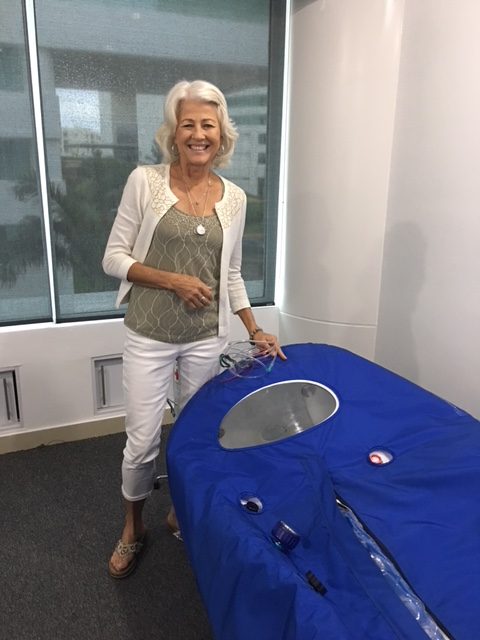Latest News
Hyperbaric Treatment for Wounds: An In-Depth Analysis

Chronic or non-healing wounds may be caused by a number of factors and may lead to a serious deterioration in the quality of life of the concerned patient. A chronic wound is essentially just a wound that either heals very slowly or does not heal at all, despite the passage of time.
Typically, such non-healing or chronic wounds are in fact ulcers associated with the poor blood circulation caused by venous or arterial diseases. On the other hand, such chronic and recurring ulcers might also be the result of severe diabetes. In this case, they are called diabetic foot ulcers, which occur when skin tissues break down, exposing the layers underneath.
One major characteristic of all non-healing or chronic wounds is that the tissues affected by the wound are almost always hypoxic. In other words, these tissues have lower than average oxygen content. This is because such wounds are often caused by poor blood circulation, which leads to a diminished supply of oxygen.
Hyperbaric Treatment for Chronic Wounds
Inevitably, those affected by chronic or non-healing wounds experience a significant reduction in the overall quality of their day-to-day lives. Many treatment options and medical procedures have been used, over the years, to provide relief to such patients. And one of the methodologies that have proved to be the most effective is the use of hyperbaric treatment for wounds.
Hyperbaric oxygen therapy, also known as HBOT, is a treatment method designed to enhance the supply of oxygen in the body and brain of the patient. An increased supply of oxygen can often prove very beneficial to wounds that have been unresponsive to other forms of treatment.
Hyperbaric treatment for wounds is administered inside a special, pressurized vessel known as a hyperbaric chamber. Once the patient enters this sealed chamber, they are able to lie down and breathe in 100 percent pure oxygen at heightened levels of atmospheric pressure.
Air pressure inside the hyperbaric chamber is typically three to five times as much as normal atmospheric pressure at sea level. This facilitates the quick absorption of the pure oxygen, which dissolves into the bodily fluids such as the plasma and the cerebrospinal fluid.
These fluids then carry the dissolved oxygen to all parts of the body, including those areas that had so far been deprived of sufficient quantities of oxygen due to damaged blood vessels. This increase in the availability of oxygen in the body leads to oxygenation, angiogenesis, and tissue regeneration. The risk of hypoxia is minimized, enabling the recovery process to begin in earnest.
The Effects of Hyperbaric Therapy
One of the key questions that this article will try to answer is whether or not the rate of recovery is enhanced when patients suffering from chronic wounds undergo hyperbaric therapy. Another factor to think about is whether or not HBOT can help minimize the need for amputation in the case of foot ulcers and related conditions. Is this treatment option safe for those with non-healing wounds as well as numerous other health conditions?
Researchers around the world have conducted numerous studies and clinical trials in order to answer these questions. For diabetic foot ulcers, scientists have found that over a period of six weeks, the chances of recovery are improved by a significant degree. The rate of improvement slows down and stabilizes after the initial period, making the improvement less drastic during follow-up studies.
Scientific evidence suggests that hyperbaric treatment for wounds might also drastically reduce the need for amputations in those living with diabetic foot ulcers. Patients suffering from chronic wounds caused by diseased veins in the limbs can also benefit from HBOT as the excess oxygen will help reduce the size of the wound.
Chronic pressure ulcers or a lack of adequate blood supply to the arteries may also cause non-healing wounds. In such cases, HBOT has been shown to facilitate recovery to a marginal extent. All clinical trials so far have also found hyperbaric treatment for wounds to be completely safe and free of any side-effects or other risks. Neither has any other adverse consequences of HBOT been reported by patients or researchers.
HBOT works via two primary processes or mechanisms, known as hyperoxygenation and bubble size reduction, respectively. Hyperoxygenation works by increasing the oxygen content in the plasma through heightened atmospheric pressure. Compartment syndrome, crush injuries, and acute blood loss anemia can be managed effectively with the help of hyperoxygenation.
Bubble size reduction, on the other hand, can help with arterial gas embolism and decompression sickness, operating on the principle that the volume of a bubble decreases when there is an increase in the air pressure of the surroundings. An increase in the availability of oxygen can also facilitate the maturation of collagen and angiogenesis, both of which are required for effective recovery from chronic wounds.
In Conclusion
The benefits of hyperbaric treatment for wounds are indisputable, but there remain many misconceptions and fears that people still have about this treatment option, which prevents them from taking advantage of the advancements that have occurred in the field of hyperbaric medicine. For the best results, patients should consult a trusted medical professional or hyperbaric expert before participating in an HBOT session.
Sebastian was born and raised in the busy city of Abbottabad. As a journalist, Saad Mushtaq has contributed to many online publications including the PAK Today and the Huffing Post. In regards to academics, Saad Mushtaq earned a degree in business from the Abbottabad UST, Havelian. Saad Mushtaq follows the money and covers all aspects of emerging tech here at The Hear Up.Thanks










